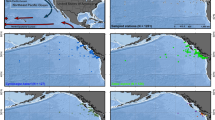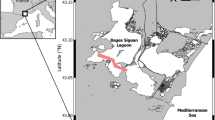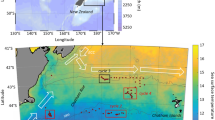Abstract
Swarms of the pelagic tunicate, Thalia democratica, form during spring, but the causes of the large interannual variability in the magnitude of salp swarms are unclear. Changes in asexual reproduction (buds per chain) of T. democratica populations in the coastal waters of south-east Australia (32–35°S) were observed in three austral springs (October 2008–2010). T. democratica abundance was significantly higher in 2008 (1,312 individuals m−3) than 2009 and 2010 (210 and 92 individuals m−3, respectively). There was a significant negative relationship (linear regression, r 2 = 0.61, F 1,22 = 33.83, P < 0.001) between abundance and asexual reproduction. Similarly, relative growth rates declined with decreasing abundance. Generalised additive mixed modelling showed that T. democratica abundance was significantly positively related to preferred food >2 μm in size (P < 0.05) and negatively related to the proportion of non-salp zooplankton (P < 0.001). Salp swarm magnitude, growth, and asexual reproduction may depend on the abundance of larger phytoplankton (prymnesiophytes and diatoms) and competition with other zooplankton.








Similar content being viewed by others
References
Alldredge AL, Madin LP (1982) Pelagic tunicates: unique herbivores in the marine plankton. Bioscience 32:655–663
Andersen V (1998) Salp and pyrosomid blooms and their importance in biogeochemical cycles. In: Bone Q (ed) The biology of pelagic tunicates. Oxford University Press, New York, pp 125–138
Barlow RG, Mantoura RFC, Gough MA, Fileman TW (1993) Pigment signatures of the phytoplankton composition in the northeastern Atlantic during the 1990 spring bloom. Deep Sea Res Part II 40:459–477
Blackburn M (1979) Thaliacea of the California current region: relations to temperature, chlorophyll, currents, and upwelling. Calif Coop Ocean Fish Investig Rep 20:184–193
Braconnot JC (1963) Study of the annual cycle of salps and doliolids in Rade de Villefranche-sur-mer. ICES/CIEM Int Counc Explor Sea 28:21–36
Brett M (2004) When is a correlation between non-independent variables “spurious”? Oikos 105:647–656
Bruland KW, Silver MW (1981) Sinking rates of fecal pellets from gelatinous zooplankton (Salps, Pteropods, Doliolids). Mar Biol 63:295–300
Clarke KR, Warwick RM (2001) Changes in marine communities: an approach to statistical analysis and interpretation. PRIMER-E, Plymouth
Clarke KR, Somerfield PJ, Gorley RN (2008) Testing of null hypotheses in exploratory community analyses: similarity profiles and biota-environment linkage. J Exp Mar Biol Ecol 366:56–69
Cresswell GR (1994) Nutrient enrichment of the Sydney continental shelf. Mar Freshw Res 45:677–691
Deibel D (1982) Laboratory determined mortality, fecundity and growth-rates of Thalia democratica Forskal and Dolioletta gegenbauri Uljanin (Tunicata, Thaliacea). J Plankton Res 4:143–153
Deibel D, Lowen B (2012) A review of the life cycles and life-history adaptations of pelagic tunicates to environmental conditions. ICES J Mar Sci 69:358–369
Deibel D, Paffenhofer GA (2009) Predictability of patches of neritic salps and doliolids (Tunicata, Thaliacea). J Plankton Res 31:1571–1579
Doblin MA, Petrou KL, Shelly K, Westwood K, van den Enden R, Wright S, Griffiths B, Ralph PJ (2011) Diel variation of chlorophyll-a fluorescence, phytoplankton pigments and productivity in the Sub-Antarctic and Polar Front Zones south of Tasmania, Australia. Deep Sea Res Part II 58:2189–2199
Dubischar CD, Bathmann UV (1997) Grazing impact of copepods and salps on phytoplankton in the Atlantic sector of the Southern Ocean. Deep-Sea Res Part II Top Stud Oceanogr 44:415–433
Everett JD, Baird ME, Suthers IM (2011) Three-dimensional structure of a swarm of the salp Thalia democratica within a cold-core eddy off southeast Australia. J Geophys Res 116:C12046
Foxton P (1966) The distribution and life-history of Salpa thompsoni Foxton with observations on a related species, Salpa gerlachei Foxton. Discov Rep 34:1–116
Goericke R, Repeta DJ (1992) The pigments of Prochlorococcus marinus—the presence of divinyl chlorophyll-a and chlorophyll-b in a marine prokaryote. Limnol Oceanogr 37:425–433
Hastie TJ, Tibshirani RJ (1990) Generalized additive models. Chapman & Hall, London
Hay S (2006) Marine ecology: gelatinous bells may ring change in marine ecosystems. Curr Biol 16:R679–R682
Henschke N, Everett JD, Baird ME, Taylor MD, Suthers IM (2011) Distribution of life history stages of the salp Thalia democratica in shelf waters during a spring bloom. Mar Ecol Prog Ser 430:49–62
Henschke N, Bowden DA, Everett JD, Holmes SP, Kloser RJ, Lee RW, Suthers IM (2013) Salp-falls in the Tasman Sea: a major food input to deep sea benthos. Mar Ecol Prog Ser. doi:10.3354/meps10450
Heron AC (1972) Population ecology of a colonizing species—pelagic tunicate Thalia democratica. 1. Individual growth-rate and generation time. Oecologia 10:269–293
Heron AC (1982) A vertical free fall plankton net with no mouth obstructions. Limnol Oceanogr 27:380–383
Heron AC, Benham EE (1984) Individual growth rates of salps in three populations. J Plankton Res 6:811–828
Heron AC, Benham EE (1985) Life history parameters as indicators of growth rate in three salp populations. J Plankton Res 7:365–379
Heron AC, McWilliam PS, Dalpont G (1988) Length weight relation in the salp Thalia democratica and potential of salps as a source of food. Mar Ecol Prog Ser 42:125–132
Jeffrey SW, Mantoura RFC, Wright SW (1997) Phytoplankton pigments in oceanography: guidelines to modern methods monographs on oceanographic methodology. UNESCO Publishing, Paris
Kemp S, Hardy MA (1929) The ships, their equipment and the methods used in research. Discov Rep 1:181–189
Lavaniegos BE, Ohman MD (2003) Long-term changes in pelagic tunicates of the California current. Deep Sea Res Part II 50:2473–2498
Le Borgne R, Moll P (1986) Growth rates of the salp Thalia democratica in Tikehau atoll (Tuamotu is.). Océanographie Tropicale 21:23–29
Lewontin RC (1965) Selection for colonizing ability. In: Baker HG, Stebbins GL (eds) The genetics of colonizing species. Academic Press, New York, pp 77–94
Licandro P, Ibanez F, Etienne M (2006) Long-term fluctuations (1974–1999) of the salps Thalia democratica and Salpa fusiformis in the northwestern Mediterranean Sea: relationships with hydroclimatic variability. Limnol Oceanogr 51:1832–1848
Madin LP, Kremer P, Wiebe PH, Purcell JE, Horgan EH, Nemazie DA (2006) Periodic swarms of the salp Salpa aspera in the Slope Water off the NE United States: biovolume, vertical migration, grazing, and vertical flux. Deep Sea Res Part I 53:804–819
Mantoura RFC, Llewellyn CA (1983) The rapid determination of algal chlorophyll and carotenoid pigments and their breakdown products in natural waters by reverse-phase high-performance liquid chromatography. Anal Chim Acta 151:297–314
Miller RL, Cosson J (1997) Timing of sperm shedding and release of aggregates in the salp Thalia democratica (Urochordata: Thaliacea). Mar Biol 129:607–614
Oke PR, Sakov P (2012) Assessing the footprint of a regional ocean observing system. J Mar Syst 105–108:30–51
Pakhomov EA, Froneman PW, Perissinotto R (2002) Salp/krill interactions in the Southern Ocean: spatial segregation and implications for the carbon flux. Deep Sea Res Part II 49:1881–1907
Partridge L, Gems D, Withers DJ (2005) Sex and death: what is the connection? Cell 120:461–472
Siegel V, Harm U (1996) The composition, abundance, biomass and diversity of the epipelagic zooplankton communities of the southern Bellinghausen Sea (Antarctic) with special reference to krill and salps. Arch Fish Mar Res 44:115–139
Sutherland KR, Madin LP, Stocker R (2010) Filtration of submicrometer particles by pelagic tunicates. Proc Natl Acad Sci USA 107:15129–15134
Thompson H (1948) Pelagic tunicates of Australia. Commonwealth Council for Scientific and Industrial Research, Melbourne, pp 136–139
Thompson H, Kesteven GL (1942) Pelagic tunicates in the plankton of south-eastern Australian waters, and their place in oceanographic studies. Council for Scientific and Industrial Research, Melbourne 153
Tranter DJ (1962) Zooplankton abundance in Australasian waters. Mar Freshw Res 13:106–142
Troedsson C, Bouquet J-M, Aksnes DL, Thompson EM (2002) Resource allocation between somatic growth and reproductive output in the pelagic chordate Oikopleura dioica allows opportunistic response to nutritional variation. Mar Ecol Prog Ser 243:83–91
Tsuda A, Nemoto T (1992) Distribution and growth of salps in a Kuroshio warm-core ring during summer 1987. Deep Sea Res Part A 39(suppl 1):S219–S229
Uitz J, Huot Y, Bruyant F, Babin M, Claustre H, Claustre H (2008) Relating phytoplankton photophysiological properties to community structure on large scales. Limnol Oceanogr 53:614–630
Vargas CA, Madin LP (2004) Zooplankton feeding ecology: clearance and ingestion rates of the salps Thalia democratica, Cyclosalpa affinis and Salpa cylindrica on naturally occurring particles in the Mid-Atlantic Bight. J Plankton Res 26:827–833
Wood SN (2006) Generalized additive models: an introduction with R. Chapman & Hall/CRC, Boca Raton
Zuur AF, Ieno EN, Walker NJ, Saveliev AA, Smith GM (2009) Mixed effects models and extensions in ecology with R (statistics for biology and health). Springer, New York
Acknowledgments
This research was funded by ARC Discovery Grant DP0880078 held by I.M.S. and Mark E. Baird. The authors thank the captain and crew of the RV Southern Surveyor 10/2008, 05/2009, 08/2010, and 09/2010. We especially thank the 08/2010 chief scientist Dr. Matthew Taylor, CSIRO scientists, and our colleagues for their assistance during the voyages. We also thank the Plankton Ecology Laboratory, CSIRO, for Port Hacking zooplankton identifications and Dr. James Smith (UNSW) for help with statistical analyses. We would like to acknowledge the valuable reviews provided by the three anonymous reviewers that have helped to improve the clarity and focus of this manuscript. This is contribution 108 from the Sydney Institute of Marine Science.
Author information
Authors and Affiliations
Corresponding author
Additional information
Communicated by U. Sommer.
Rights and permissions
About this article
Cite this article
Henschke, N., Everett, J.D., Doblin, M.A. et al. Demography and interannual variability of salp swarms (Thalia democratica). Mar Biol 161, 149–163 (2014). https://doi.org/10.1007/s00227-013-2325-2
Received:
Accepted:
Published:
Issue Date:
DOI: https://doi.org/10.1007/s00227-013-2325-2




